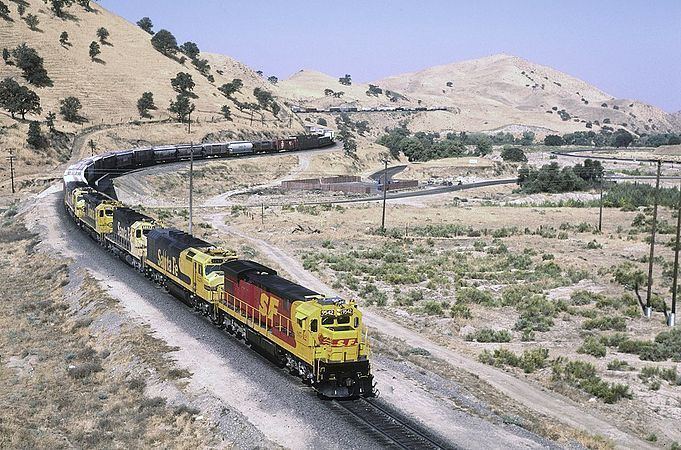 | ||
In the 1980s, The Atchison, Topeka and Santa Fe Railway (SF) and Southern Pacific Transportation Company (SP) attempted a merger. It began with the merger of holding companies Santa Fe Industries and Southern Pacific Company on December 23, 1983 to form the Santa Fe Southern Pacific Corporation (SFSP), which held the SP shares in a voting trust. After the Interstate Commerce Commission denied the merger, SFSP sold the SP to Rio Grande Industries on October 13, 1988, and was renamed Santa Fe Pacific Corporation on April 25, 1989.
Contents
History
The merger was opposed by the Justice Department in 1985 and denied in a 4–1 vote by the Interstate Commerce Commission (ICC) on July 24, 1986, who ruled that such a merger included too many duplicate routes and was therefore monopolistic. The Commission denied SFSP's appeal (again in a 4–1 vote) on June 30, 1987.
The holding company, ordered to operate the Southern Pacific at arm's length until it sold it, disposed of it on October 13, 1988 to Rio Grande Industries for $1.02 billion and the assumption of SP's debt, which consolidated the SP with its Denver and Rio Grande Western railroad under the Southern Pacific name. The holding company retained all the non-rail interests of both predecessors and shortened its name to Santa Fe Pacific Corporation (though all of the California real estate holdings were consolidated in a new company, Catellus Development Corporation, becoming the State's largest private land owner. Catellus subsequently purchased the Union Pacific Railroad's interest in the Los Angeles Union Passenger Terminal).
In 1995, the Santa Fe railroad merged with the Burlington Northern Railroad to form The Burlington Northern and Santa Fe Railway (BNSF), and the SP was bought out by the Union Pacific Railroad the following year.
"Kodachrome" paint scheme
The holding company controlled all the rail and non-rail assets of the former Santa Fe Industries and Southern Pacific Company, and it was intended that the two railroads would be merged. They were confident enough that this would be approved that they began repainting locomotives into a new unified paint scheme, including the letters SP or SF and an adjacent empty space for the other two (as SPSF, the reverse order of the holding company).
The locomotive livery featured the Santa Fe's Yellowbonnet with a red stripe on the locomotive's nose; the remainder of the locomotive body was painted in Southern Pacific's scarlet red (from their Bloody Nose scheme) with a black roof and black extending down to the lower part of the locomotive's radiator grills. The numberboards were red with white numbers. In large block letters within the red portion of the sides was either "SP" (for Southern Pacific-owned locomotives) or "SF" (for Santa Fe-owned locomotives). The lettering was positioned on the locomotive sides so that the other half of the lettering could be added after the merger became official. One locomotive was painted with the full SPSF lettering to show what the unified paint scheme would look like after the merger was complete. One Santa Fe caboose was also painted with "SPSF" in a similar situation.
This paint scheme, combining yellow, red and black, has come to be called the Kodachrome paint scheme due to the colors' resemblance to those on the boxes that Kodak used to package its Kodachrome slide film (which was heavily used by railfans of the time). After the ICC's denial, railfans joked that SPSF really stood for "Shouldn't Paint So Fast".
At the time of merger denial, approximately 306 ATSF locomotives, 4 ATSF cabooses, 10 ATSF slugs, 96 SP locomotives, and 1 SP caboose had been painted in this fashion. The two railroads made an effort to repaint locomotives in their standard paint schemes after the merger was denied. Santa Fe repainted all Kodachromes still on roster by 1990, though some engines were sold in this scheme. Southern Pacific's less numerous Kodachromes were repainted much more slowly; some remained active on the Union Pacific after the SP buyout; a few Kodachrome-painted locomotives still operate in lease service today. One GP9 locomotive (ex-SP 2873) is operated by the Western Pacific Railroad Museum in Portola, CA. Another Kodachrome that exists is an SD40R (ex-SP 7357) still in service with the Trona Railway as TRC 2003.
